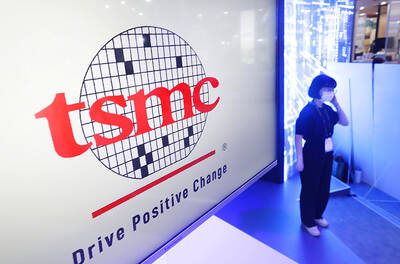Taiwan Ratings Corp (中華信評) on Thursday affirmed its long-term “twA” and short-term “twA-1”’ credit ratings for Acer Inc (宏碁), with a stable credit outlook for the PC vendor.
The credit rating of a corporation is a financial indicator to potential investors of debt securities such as bonds.
Under Taiwan Ratings’ scale, “twA” is the sixth-highest level in the long-term issuer credit ratings regarding a company’s capacity to meet its financial commitments over a period of one year and above, while the “twA-1” short-term rating represents the fifth-highest for obligations less than 365 days.

Photo: Vanessa Cho, Taipei Times
“The stable outlook embeds our view that Acer could continue to register faster growth in Chromebook and gaming PC sales to sustain its revenue and margins, enabling the company to generate satisfactory positive free operating cash flow and sustain a net cash position over the next one to two years,” Taiwan Ratings, the local arm of Standard & Poor’s Global Ratings, said in a statement.
Work-from-home demand has remained strong a year after the outbreak of COVID-19, especially for educational products such as Chromebooks. Acer and its local peer Asustek Computer Inc (華碩) have said that growth momentum for Chromebooks has extended into this year from last year.
Taiwan Ratings said Chromebook demand last year nearly doubled from 2019, as the pandemic stimulated demand for cheaper devices for remote learning, which does not require high performance.
Demand is likely to remain strong this year, amid the ongoing pandemic and the growing popularity of PC gaming, it said, adding that gaming PCs have seen a much higher growth rate than the overall PC market during the pandemic.
“Acer’s much smaller market share and weaker brand name than that of its larger peers in the mature global PC market and relatively low profitability constrain its competitive position,” Taiwan Ratings said.
“However, Acer could take advantage of fast-growing gaming PC and Chromebook demand to sustain its market share with moderately strengthening profitability over the next two years,” it added.
Acer secured a 6.9 percent share of the global PC market last year, up from 6.4 percent in 2019, International Data Corp has said.
Its revenue reached NT$277.09 billion (US$9.8 billion) last year, up 18.27 percent from a year earlier and the highest level in six years, company data showed.
The company’s focus on growing its gaming PC and Chromebook segments is expected to help sustain its revenue growth this year, and therefore sustain its market share in the global PC market, Taiwan Ratings said.
Nonetheless, the company’s shipments and revenue next year might be negatively affected by a waning demand for remote working and remote learning, it said.
Acer remains positive for the global PC market this year, as PC demand is still far greater than supply, chairman Jason Chen (陳俊聖) said on Wednesday, local Chinese-language media reported.
The PC industry would continue to see shortages of key components, such as wafers, ICs and flat panels, as the whole supply chain has been strained by strong market demand, Chen said.
“There is no relief of this supply constraint in the foreseeable future,” the Chinese-language Commercial Times quoted Chen as saying on Thursday. “The busiest thing now is to grab production capacity, communicate with the supply chain, and strive to chase goods.”

ADVANCED: Previously, Taiwanese chip companies were restricted from building overseas fabs with technology less than two generations behind domestic factories Taiwan Semiconductor Manufacturing Co (TSMC, 台積電), a major chip supplier to Nvidia Corp, would no longer be restricted from investing in next-generation 2-nanometer chip production in the US, the Ministry of Economic Affairs said yesterday. However, the ministry added that the world’s biggest contract chipmaker would not be making any reckless decisions, given the weight of its up to US$30 billion investment. To safeguard Taiwan’s chip technology advantages, the government has barred local chipmakers from making chips using more advanced technologies at their overseas factories, in China particularly. Chipmakers were previously only allowed to produce chips using less advanced technologies, specifically

BRAVE NEW WORLD: Nvidia believes that AI would fuel a new industrial revolution and would ‘do whatever we can’ to guide US AI policy, CEO Jensen Huang said Nvidia Corp cofounder and chief executive officer Jensen Huang (黃仁勳) on Tuesday said he is ready to meet US president-elect Donald Trump and offer his help to the incoming administration. “I’d be delighted to go see him and congratulate him, and do whatever we can to make this administration succeed,” Huang said in an interview with Bloomberg Television, adding that he has not been invited to visit Trump’s home base at Mar-a-Lago in Florida yet. As head of the world’s most valuable chipmaker, Huang has an opportunity to help steer the administration’s artificial intelligence (AI) policy at a moment of rapid change.

Taiwan Semiconductor Manufacturing Co’s (TSMC, 台積電) quarterly sales topped estimates, reinforcing investor hopes that the torrid pace of artificial intelligence (AI) hardware spending would extend into this year. The go-to chipmaker for Nvidia Corp and Apple Inc reported a 39 percent rise in December-quarter revenue to NT$868.5 billion (US$26.35 billion), based on calculations from monthly disclosures. That compared with an average estimate of NT$854.7 billion. The strong showing from Taiwan’s largest company bolsters expectations that big tech companies from Alphabet Inc to Microsoft Corp would continue to build and upgrade datacenters at a rapid clip to propel AI development. Growth accelerated for

TARIFF SURGE: The strong performance could be attributed to the growing artificial intelligence device market and mass orders ahead of potential US tariffs, analysts said The combined revenue of companies listed on the Taiwan Stock Exchange and the Taipei Exchange for the whole of last year totaled NT$44.66 trillion (US$1.35 trillion), up 12.8 percent year-on-year and hit a record high, data compiled by investment consulting firm CMoney showed on Saturday. The result came after listed firms reported a 23.92 percent annual increase in combined revenue for last month at NT$4.1 trillion, the second-highest for the month of December on record, and posted a 15.63 percent rise in combined revenue for the December quarter at NT$12.25 billion, the highest quarterly figure ever, the data showed. Analysts attributed the